Lembosiniella eucalyptorum Crous & Carnegie, sp. nov.
MycoBank number: MB 832021; Index Fungorum number: IF 832021; Facesoffungi number: FoF 12259; Fig. 47.
Etymology: Name refers to Eucalyptus, the host genus from which this fungus was collected.
Ascomata predominantly hypophyllous, black, superficial, hysterothecial, 150 – 350 μm diam, with feathery margin, opening by longitudinal or Y-shaped split, margin with cells of textura epidermoidea. Asci intermingled among pseudoparaphyses, hyaline, septate, hypha-like, 3– 4 μm diam, with obtuse ends. Asci obovoid to ellipsoid, bitunicate, 8-spored, with apical chamber, 2 – 3 μm diam, 40– 60 × 21– 30 μm. Ascospores multiseriate in asci, fusoid- ellipsoid, straight, ends obtuse, prominently constricted at median septum, thick-walled, with 1– 2 large guttules per cell, hyaline, smooth, becoming brown and verruculose, (26 –)30– 35(– 37) × 8– 9(– 10) μm. Germinating ascospores dark brown, distorting, verruculose, covered in mucoid layer, germinating with 1– 2 brown, verruculose germ tubes that are prominently constricted at septa; ascospores 5– 12 μm diam, with germ tubes parallel or perpendicular to the long axis of the spore.
Culture characteristics: Colonies erumpent, spreading, with sparse aerial mycelium and smooth margin, reaching 5 mm diam after 2 wk at 25 °C. On MEA surface greenish black, reverse olivaceous grey; on PDA surface greenish black, reverse olivaceous grey with diffuse yellow pigment in agar; on OA surface greyish sepia.
Typus: Australia, New South Wales, Tooloom, Beury State Forest plantation, Tin Hut Forestry Rd, S28°35’35.0”, E152°21’44.9”, on E. dunnii, 20 Jan. 2016, A.J. Carnegie, HPC 1443 (holotype CBS H-24028, culture ex-type CBS 144603 = CPC 31816).
Notes: Lembosina eucalypti is reminiscent of Thyrinula eucalypti (= Aulographina eucalypti), except that the ascospores are hyaline in the latter genus. The type species of Lembosina occurs as a saprobe on twigs of Rhododendron in the Netherlands, and is not congeneric with Lembosiniella eucalypti, which has hysterothecia opening with a longitudinal slit, and is pathogenic to Eucalyptus. Lembosiniella eucalyptorum [ascospores (26–) 30– 35(– 37) × 8– 9(– 10) μm] is similar to L. eucalypti (ascospores 20– 32 × 5.5 – 7.5 μm), although ascospores of L. eucalyptorum are longer and wider (Sivanesan & Shivas 2002c). The ITS sequence of Lembosiniella eucalyptorum is not close to any sequence in GenBank, whereas the LSU sequence is 95 % similar to those of species of Elsinoe, sug-gesting an affinity with Myrangiales.

Fig. 47. Lembosiniella eucalypti (BRIP 25821). A. Disease symptoms. B. Surface view of ascomata. C. Vertical section through hysterothecium. D. Ascus. E. Ascospores. Scale bars = 10 μm. F– M. L. eucalyptorum (CPC 31816). F, G. Disease symptoms. H. Hysterothecium. I. Colony on MEA. J, K. Asci. L. Ascospores. M. Germinating as- cospores. Scale bars: H = 300 μm, all others = 10 μm.
Species
